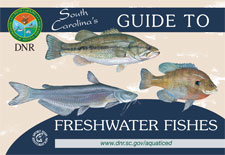Freshwater Fish - Species
Species Specific Regulations
Green sunfish
Freshwater Fishing License required.
Green sunfish (Lepomis cyanellus)
Description: (Anatomy of a Fish)
Green sunfish have a slender, thick body with a large mouth and an upper jaw that extends back to the near middle of the eye. Its body is greenish-brown with irregular rows of metallic blue-green flecks along its sides. From the mouth to the cheeks and the operculum, iridescent blue lines radiate. A distinctive large black blotch is present on the rear of the dorsal fin and on the anal fin. The soft dorsal and anal fins, pelvic and caudal fins are edged with white followed by a faint, but distinct, yellow-orange edge. The pectoral fin is short and rounded. The opercular lobe is short and black with a wide pale margin.
Range: Mostly in the Blue Ridge and Piedmont foothills, but may also be found in parts of the Coastal Plain.
Average Length: 4-6 inches
Average Size: 3-6 ounces
South Carolina State Record: Unknown
Life Expectancy: Approximately 7 years
Preferred Habitat
Green sunfish prefer slow pools and backwaters of streams and rivers, but they also occur in ponds, lakes and reservoirs. They are highly tolerant of turbidity and drought conditions. Food Habits: Aquatic insects, crayfish and small fishes.
Food Habits
- Aquatic insects, crayfish and small fishes.
Spawning
- From April through August, green sunfish spawn almost always making nest near some type of shelter such as a log or clumps of vegetation over gravel or sand.
- Green sunfish nests are often located in large groups. Depending on the female's size, she can lay between 2,000 and 10,000 eggs per spawning season.
Miscellaneous
Green sunfish are the most resilient and top competitors of all the sunfishes. They can withstand extreme changes in temperature and most disturbed habitats. They often out-compete and suppress native fish populations in disturbed or marginal habitats. They can rapidly colonize new habitats too.
Commonly Mistaken Species
One species of fish that is commonly mistaken for this species:
Literature Cited
Rohde, Fred C, Arndt, Rudolf G., Foltz, Jeffery W., Quattro, Joseph M. 2009. Freshwater Fishes of South Carolina. University of South Carolina Press, Columbia, South Carolina.
Wildlife and Freshwater Fisheries Division. 2009. South Carolina Guide to Freshwater Fishes.
Fish Illustration by Duane Raver.


